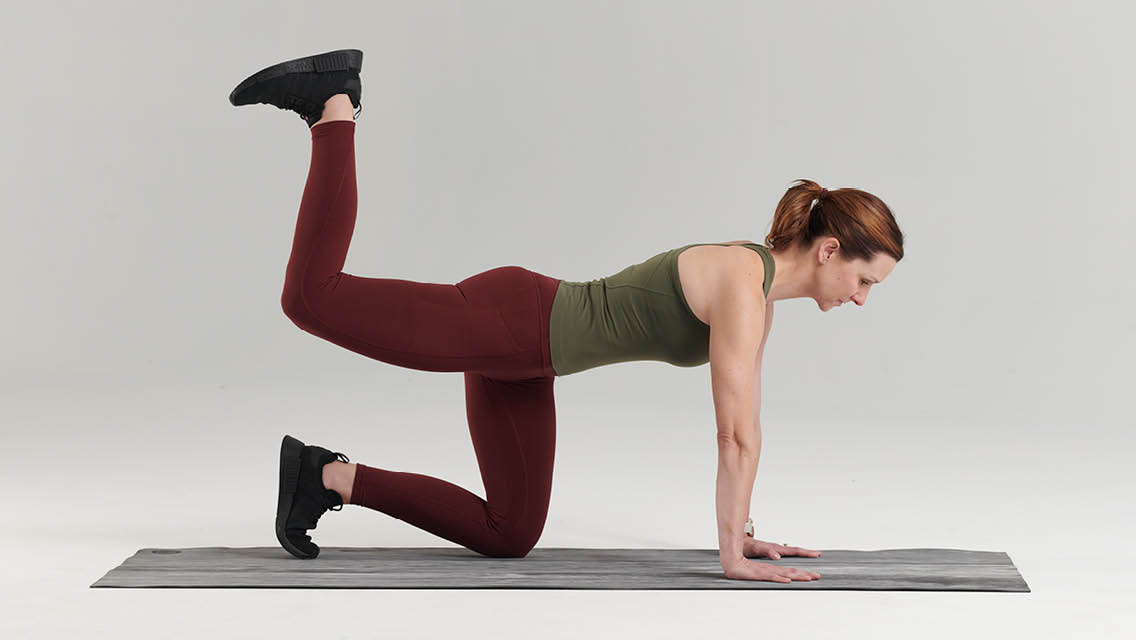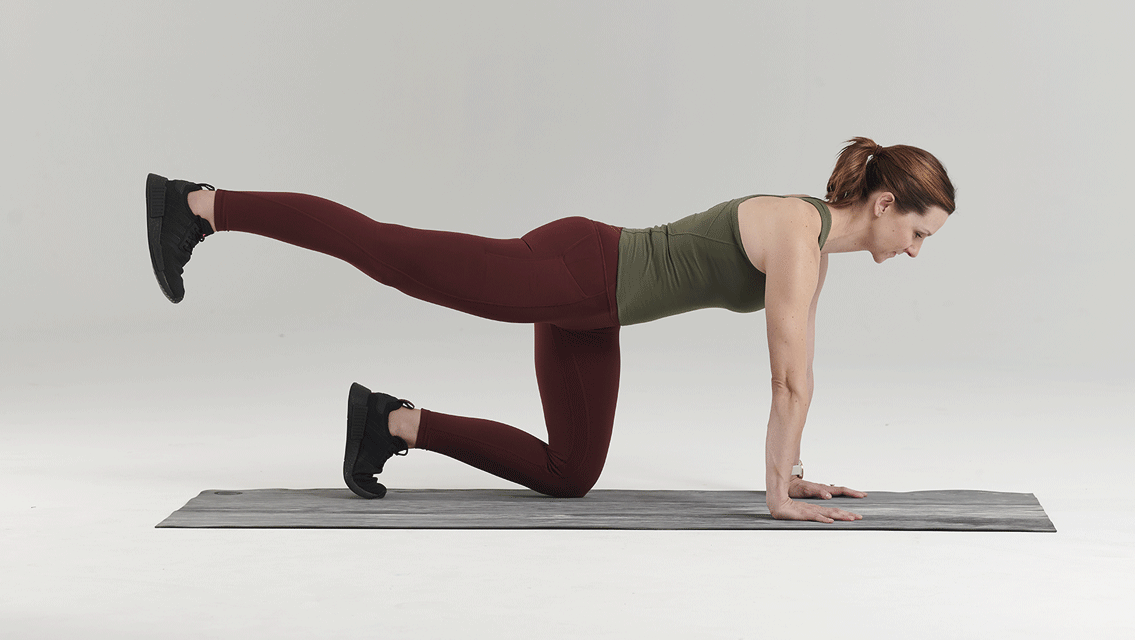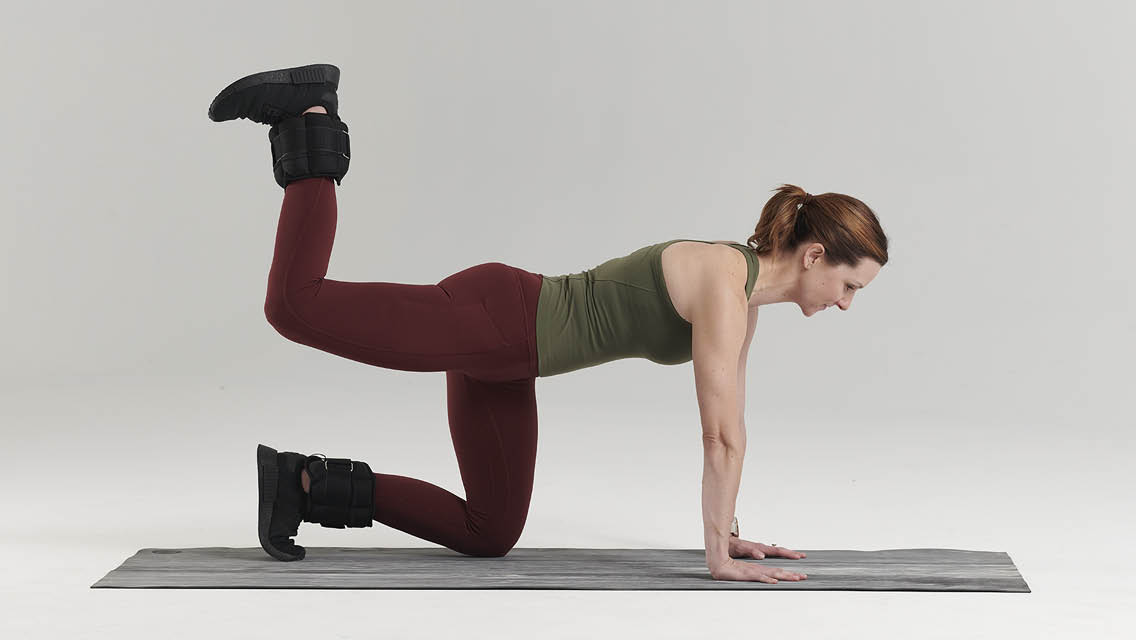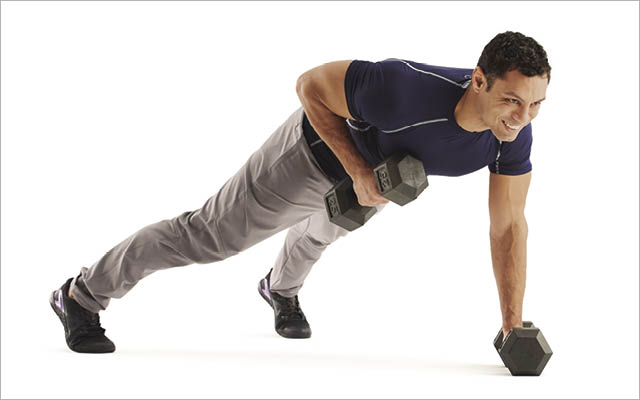The donkey kick is a staple gym exercise for goals as varied as rehabbing weak hips, building lumbo-pelvic stability, or growing a bigger booty. In addition to the glute muscles of the working leg, this low-impact move also engages the shoulders, core, and muscles of the supporting leg. The donkey kick helps build balance, coordination, and spatial awareness, too.
Aim to avoid these common pitfalls:
- Reaching your toes to the ceiling. A higher lift doesn’t produce better results — it can disengage the glutes and set you up to arch your back and tilt your hips.
- Disengaging your base. Press actively through your hands and feet. Engage your abs to maintain a flat back. Engage your base-side hip to make sure it remains over the knee.
- Moving too quickly. Donkey kicks are all about engagement, so move slowly and with control.
- Adding too much weight. Donkey kicks are commonly done with just body weight, but the move can be progressed by using ankle weights, a resistance band, or a cable machine. Be sure to master good form first, and don’t add so much weight that your form breaks down.

Instructions
- Assume an all-fours position, with your wrists under your shoulders, your knees under your hips, and your neck in a neutral position.
- Engage your core to keep your back flat and parallel to the floor; actively press through your hands and feet.
- Keep your knee bent at 90 degrees and flex your foot, then lift one leg until your thigh is about parallel to the floor.
- Pause briefly at the top of the movement, then lower. Perform 15 to 20 reps, then switch sides.
Additional Form Tips
- Flex the foot of the lifting leg as though you are trying to stamp a low ceiling with your sole. Engage the working-side glute, not reaching for the ceiling with your toes.
- The toes of your base leg can be tucked or flat, as long as you can engage that leg and actively press through the foot.
- Keep your hips level and squared to the floor.
- Do not arch your back up or down.
- Do not shift your weight into the hip of the base leg.
Donkey Kick Variations
Donkey Kickback
Because you are kicking back instead of up, the donkey kickback is a good option for people who struggle to maintain a flat back during the move. It’s not a one-for-one swap with the standard donkey kick, but the kickback works the same muscles in a different way. Neither is better or worse, or easier or harder — just different enough that one version might be better suited to you.

- Assume an all-fours position, with your wrists under your shoulders, your knees under your hips, and your neck in a neutral position.
- Engage your core to keep your back flat and parallel to the floor, and actively press through your hands and feet.
- With a flexed foot, lift and extend your right leg, kicking straight back (instead of up) until your leg is parallel to the floor. Think about squeezing your working glute and actively pushing your heel to the wall behind you.
- Pause briefly at the top of the movement, then lower. Repeat for the desired number of reps, then switch sides.
Donkey Kick With Ankle Weights

- Secure a set of ankle weights around your ankles or above your knees.
- Assume an all-fours position, with your wrists under your shoulders, your knees under your hips, and your neck in a neutral position.
- Engage your core to keep your back flat and parallel to the floor, and actively press through your hands and feet.
- Keeping the 90-degree angle of the knee joint, lift your right leg up. Flex the right foot and use your glutes to lift the leg until your thigh is about parallel to the floor.
- Pause briefly at the top of the movement, then lower. Repeat for the desired number of reps, then switch sides.
- Alternatively, you can perform the kickback variation with ankle weights.
- Note: If the added weight causes discomfort or pain, or prevents you from maintaining great form, lower the weight or remove the added load entirely.
Donkey Kick With Short Resistance Band

- Position the band around your thighs just above the knees.
- Assume an all-fours position, with your wrists under your shoulders, your knees under your hips, and your neck in a neutral position.
- Engage your core to keep your back flat and parallel to the floor, and actively press through your hands and feet.
- Keeping the 90-degree angle of the knee joint, lift your right leg up. Flex the right foot and use your glutes to lift the leg until your thigh is about parallel to the floor.
- Pause briefly at the top of the movement, then lower. Repeat for the desired number of reps, then switch sides.
- Alternatively, you can perform the kickback variation with a band.
- Note: If the added weight causes discomfort or pain, or prevents you from maintaining great form, use a lighter band or remove the added load entirely.
Donkey Kick With Cable Machine
- Attach the ankle-strap attachment to the bottom of the pulley and adjust the weight on the cable machine accordingly, erring on the side of starting too light.
- Wrap the ankle strap around your ankle and assume an all-fours position facing the machine, with your wrists under your shoulders, your knees under your hips, and your neck in a neutral position.
- Engage your core to keep your back flat and parallel to the floor, and actively press through your hands and feet.
- Keeping the 90-degree angle of the knee joint, lift your right leg up. Flex the right foot and use your glutes to lift the leg until your thigh is about parallel to the floor.
- Pause briefly at the top of the movement, then lower. Repeat for the desired number of reps, then switch sides.
- Alternatively, you can perform the kickback variation with the ankle strap of the cable machine.
- Note: If the added weight causes discomfort or pain, or prevents you from maintaining great form, decrease the weight or remove the added load entirely.
This article originally appeared as “The Donkey Kick” in the May 2023 issue of Experience Life.





This Post Has 0 Comments